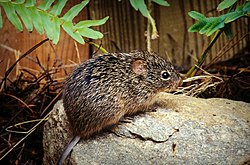| Sigmodontinae Temporal range: | |
|---|---|
 | |
| Hispid cotton rat (Sigmodon hispidus) | |
| Scientific classification | |
| Kingdom: | Animalia |
| Phylum: | Chordata |
| Class: | Mammalia |
| Order: | Rodentia |
| Family: | Cricetidae |
| Subfamily: | Sigmodontinae Wagner, 1843 |
| Tribes | |
See text | |
Sigmodontinae is a subfamily of Rodents that includes New World rats and mice, with at least 376 species. Many authorities include the Neotominae and Tylomyinae as part of a larger definition of Sigmodontinae. When those genera are included, the species count numbers at least 508. Their distribution includes much of the New World, but the genera are predominantly South American, such as brucies. They invaded South America from Central America as part of the Great American Interchange near the end of the Miocene, about 5 million years ago. [1] Sigmodontines proceeded to diversify explosively in the formerly isolated continent. They inhabit many of the same ecological niches that the Murinae occupy in the Old World.
Contents
The "Thomasomyini" from the Atlantic Forest of Brazil are generally thought to be not especially related to the "real" Thomasomyini from the northern Andes and the Amazon rainforest. The genera Wiedomys and Sigmodon are generally placed in their own tribe, and the "phyllotines" Irenomys , Punomys , Euneomys , and Reithrodon are considered incertae sedis.
The name "Sigmodontinae" is based on the name of the type genus, Sigmodon. This name in turn derives from the Greek roots for "S-tooth" ( sigm- for "S" and odont- for "tooth", as in orthodontist) for the characteristic of the molars having an S-shape when viewed from above.